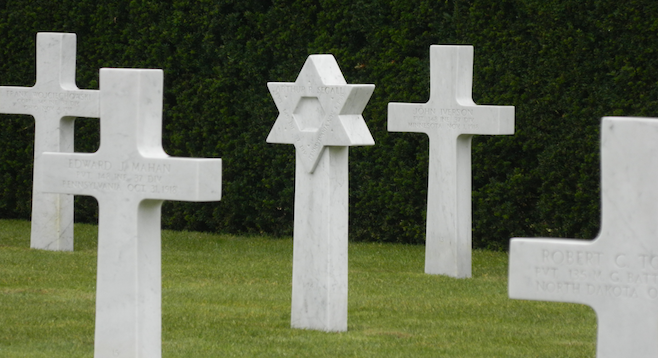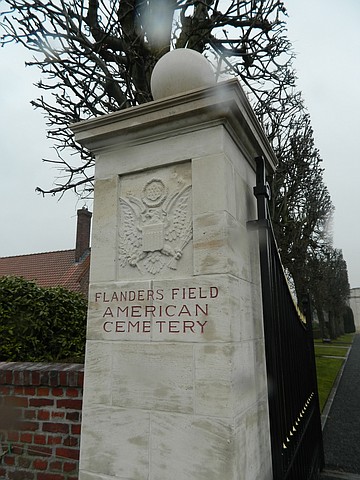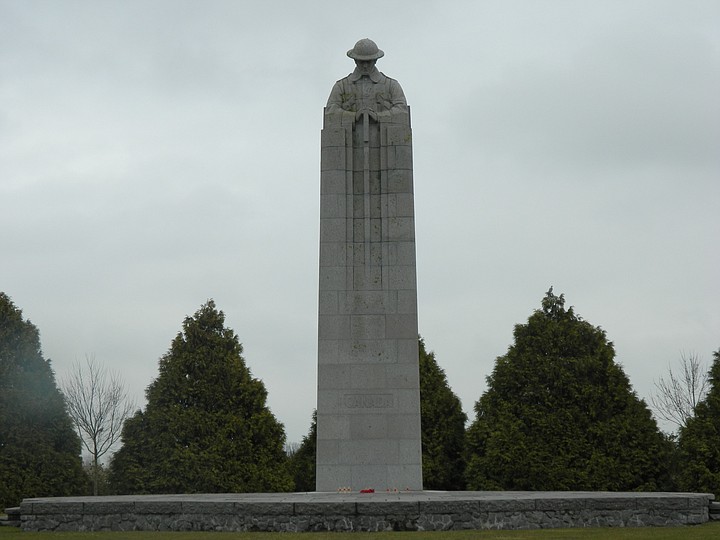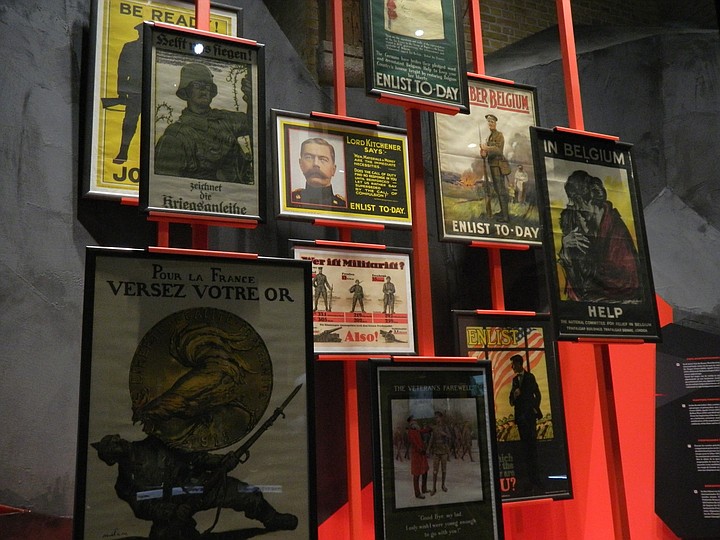 Facebook
Facebook
 X
X
 Instagram
Instagram
 TikTok
TikTok
 Youtube
Youtube

Though the reasons for WWI are murky to most Americans – something about the assassination of an Archduke, as well as the unification of feudal-era principalities into modern nation-states – the war brought our country into the modern era. The introduction of airplanes and chemical weapons (such weapons were first used at Ypres) are certainly issues that remain with us today.
The battles that took place in the region of Belgium known as Flanders, including the town of Ypres, are known as “Flanders Fields,” attributable to the poem of Canadian surgeon and Lt. Col. John McCrae. His poem, In Flanders Fields, was written to commemorate his fallen friend. As a tribute to the Ypres battle that took over 100,000 lives, many of our allied vets wear silk poppies on November 11.
True to a Shakespearean congruency of nature, blood-red poppies were the only living thing that would grow in the area. The flowers were fertilized by decomposing bodies. In Flanders Fields was considered both stirring and inspirational, and was later used for recruitment.
Where to stay. When visiting war-scarred fields, simple seems to feel perfect in a hotel. But there’s an art to “simple.” When it’s done right, you seem to have everything you could ever want – even a front desk with extra power adapters – and nothing extraneous. Novotel Ieper’s (the British spelling of the city’s name) rooms have wooden hanging structures instead of closets, but everything fits. The soaking tub is rare in a European hotel bathroom. The coffee and tea in your room is refilled in the afternoon.

What to do. Flanders Field American Cemetery and Memorial in Waregem (left) is less than an hour’s drive to Ypres. It's a good reference point to further examine our role in WWI. After the war, in 1921, widows were given the opportunity to have the return of the bodies to the U.S. Some had remarried by then and chose to leave the fallen soldiers where they were. Parents of the deceased had no say in the matter.
Closer to Ypres, there are many, many cemeteries and monuments. Tyne Cot, the largest Commonwealth cemetery in the world, has over 8,000 unidentified soldiers, 70% of its total. As you look at evidence of carnage in the area, the effect is staggering.

The Canadian monument The Brooding Soldier is located in St. Julien. This 36-foot-high stone monument depicts a solder leaning forward on his gun, saddened by everything in his vista. What many people don’t know is that thousands of Americans volunteered with Canadian forces before the U.S. entered the war – due to family connections, ethic ties, the ability to fly with the Canadian Royal Flying Corps and other personal reasons. Thousands of these volunteers also died.

In the actual town of Ypres, there’s a new museum dedicated to WWI, In Flanders Fields Museum. With its engaging displays the museum endeavors to explain the complicated political entanglements of the era. Its collection includes uniforms and weaponry from many different countries, rare multimedia and contemporary artifacts. There’s a bell tower to climb and view the area, as well as a café serving regional fare.
Every single evening at 8 p.m. sharp at Menin Gate in Ypres, The Last Post is played. This is the traditional final salute to the fallen, played by the buglers in honor of the memory of the soldiers of the former British Empire and its allies, who died in the Ypres Salient during the First World War.
Menin Gate is an impressive, huge structure... but even as large as it is, its walls were found to be only big enough hold the names of half of the 90,000 soldiers killed in the region. Other names had to be added to an Allied cemetery.
The moving Last Post ceremony is free; it’s been attended by vets, civilians and dignitaries from around the world since its inception in 1928. Wreaths of poppies are placed at the monument. Those wishing to commemorate veterans, loved ones, etc., can ask permission to be part of the wreath dedication ceremony by contacting The Last Post Association.
What to eat. After looking at monuments and thinking about mortality all day, it feels good to replenish with a hearty meal. Within walking distance of Menin Gate is the Hotel Regina and its in-house restaurant. It definitely doesn’t feel like a traditional hotel restaurant; it’s young, hip and frequented by locals.
One of Flanders' regional culinary specialties is called waterzooi. That's a traditional white roux-based stew, formerly made with fish but more commonly made with chicken these days. A mirepoix is added, along with potatoes and herbs, but not too many. It's a very mild comfort food dish. It was a favorite of Holy Roman Emperor Charles V, but locals – 500 years later – still do things to him in effigy, etc., to protest his high taxing ways. At any rate, they kept the waterzooi.
I learned that Regina makes theirs with the creamier white roux, while others have a clearer sauce. Theirs had big, thick chicken breasts in it. It's kind of a cross between a soup and a stew.


Though the reasons for WWI are murky to most Americans – something about the assassination of an Archduke, as well as the unification of feudal-era principalities into modern nation-states – the war brought our country into the modern era. The introduction of airplanes and chemical weapons (such weapons were first used at Ypres) are certainly issues that remain with us today.
The battles that took place in the region of Belgium known as Flanders, including the town of Ypres, are known as “Flanders Fields,” attributable to the poem of Canadian surgeon and Lt. Col. John McCrae. His poem, In Flanders Fields, was written to commemorate his fallen friend. As a tribute to the Ypres battle that took over 100,000 lives, many of our allied vets wear silk poppies on November 11.
True to a Shakespearean congruency of nature, blood-red poppies were the only living thing that would grow in the area. The flowers were fertilized by decomposing bodies. In Flanders Fields was considered both stirring and inspirational, and was later used for recruitment.
Where to stay. When visiting war-scarred fields, simple seems to feel perfect in a hotel. But there’s an art to “simple.” When it’s done right, you seem to have everything you could ever want – even a front desk with extra power adapters – and nothing extraneous. Novotel Ieper’s (the British spelling of the city’s name) rooms have wooden hanging structures instead of closets, but everything fits. The soaking tub is rare in a European hotel bathroom. The coffee and tea in your room is refilled in the afternoon.

What to do. Flanders Field American Cemetery and Memorial in Waregem (left) is less than an hour’s drive to Ypres. It's a good reference point to further examine our role in WWI. After the war, in 1921, widows were given the opportunity to have the return of the bodies to the U.S. Some had remarried by then and chose to leave the fallen soldiers where they were. Parents of the deceased had no say in the matter.
Closer to Ypres, there are many, many cemeteries and monuments. Tyne Cot, the largest Commonwealth cemetery in the world, has over 8,000 unidentified soldiers, 70% of its total. As you look at evidence of carnage in the area, the effect is staggering.

The Canadian monument The Brooding Soldier is located in St. Julien. This 36-foot-high stone monument depicts a solder leaning forward on his gun, saddened by everything in his vista. What many people don’t know is that thousands of Americans volunteered with Canadian forces before the U.S. entered the war – due to family connections, ethic ties, the ability to fly with the Canadian Royal Flying Corps and other personal reasons. Thousands of these volunteers also died.

In the actual town of Ypres, there’s a new museum dedicated to WWI, In Flanders Fields Museum. With its engaging displays the museum endeavors to explain the complicated political entanglements of the era. Its collection includes uniforms and weaponry from many different countries, rare multimedia and contemporary artifacts. There’s a bell tower to climb and view the area, as well as a café serving regional fare.
Every single evening at 8 p.m. sharp at Menin Gate in Ypres, The Last Post is played. This is the traditional final salute to the fallen, played by the buglers in honor of the memory of the soldiers of the former British Empire and its allies, who died in the Ypres Salient during the First World War.
Menin Gate is an impressive, huge structure... but even as large as it is, its walls were found to be only big enough hold the names of half of the 90,000 soldiers killed in the region. Other names had to be added to an Allied cemetery.
The moving Last Post ceremony is free; it’s been attended by vets, civilians and dignitaries from around the world since its inception in 1928. Wreaths of poppies are placed at the monument. Those wishing to commemorate veterans, loved ones, etc., can ask permission to be part of the wreath dedication ceremony by contacting The Last Post Association.
What to eat. After looking at monuments and thinking about mortality all day, it feels good to replenish with a hearty meal. Within walking distance of Menin Gate is the Hotel Regina and its in-house restaurant. It definitely doesn’t feel like a traditional hotel restaurant; it’s young, hip and frequented by locals.
One of Flanders' regional culinary specialties is called waterzooi. That's a traditional white roux-based stew, formerly made with fish but more commonly made with chicken these days. A mirepoix is added, along with potatoes and herbs, but not too many. It's a very mild comfort food dish. It was a favorite of Holy Roman Emperor Charles V, but locals – 500 years later – still do things to him in effigy, etc., to protest his high taxing ways. At any rate, they kept the waterzooi.
I learned that Regina makes theirs with the creamier white roux, while others have a clearer sauce. Theirs had big, thick chicken breasts in it. It's kind of a cross between a soup and a stew.
Comments